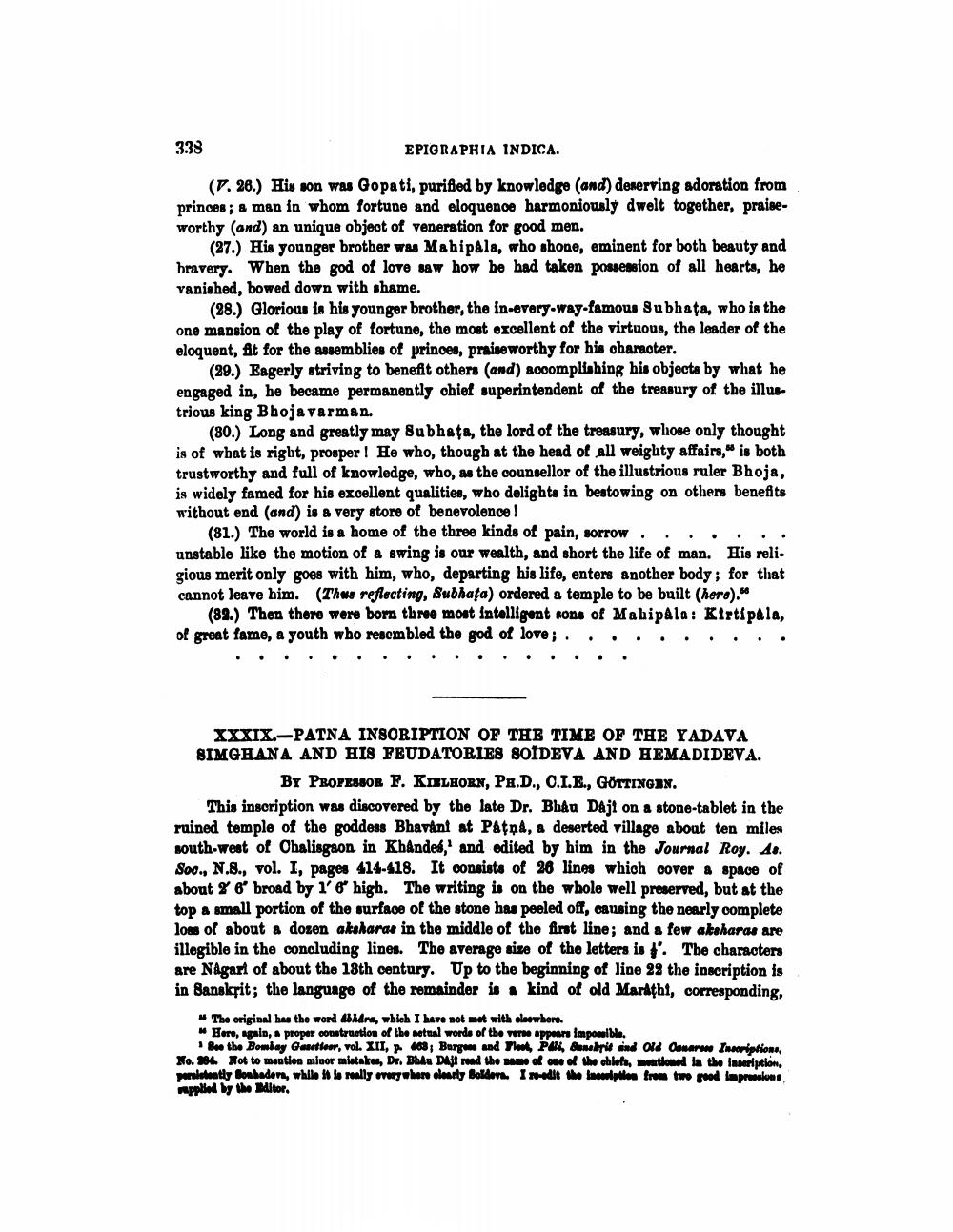________________
338
EPIGRAPHIA INDICA.
(7.26.) His son was Gopati, purified by knowledge (and) deserving adoration from princes; a man in whom fortune and eloquence harmoniously dwelt together, praiseworthy (and) an unique object of veneration for good men.
(27.) His younger brother was Mahipala, who shone, eminent for both beauty and bravery. When the god of love saw how he had taken possession of all hearts, he vanished, bowed down with shame.
(28.) Glorious is his younger brother, the in-every-way-famous Subhata, who is the one mansion of the play of fortune, the most excellent of the virtuous, the leader of the eloquent, fit for the assemblies of princes, praiseworthy for his character.
(29.) Eagerly striving to benefit others (and) accomplishing his objects by what he engaged in, he became permanently chief superintendent of the treasury of the illustrious king Bhojavarman.
(80.) Long and greatly may Bubhata, the lord of the treasury, whose only thought is of what is right, prosper! He who, though at the head of all weighty affairs," is both trustworthy and full of knowledge, who, as the counsellor of the illustrious ruler Bhoja, is widely famed for his excellent qualities, who delights in bestowing on others benefits without end (and) is a very store of benevolence!
(81.) The world is a home of the three kinds of pain, sorrow
unstable like the motion of a swing is our wealth, and short the life of man. His religious merit only goes with him, who, departing his life, enters another body; for that cannot leave him. (Thus reflecting, Subhata) ordered a temple to be built (here).
(82.) Then there were born three most intelligent sons of Mahipala: Kirtipala, of great fame, a youth who resembled the god of love; .
XXXIX-PATNA INSORIPTION OF THE TIME OF THE YADAVA SIMGHANA AND HIS FEUDATORIES SOÏDEVA AND HEMADIDEVA.
BY PROFESSOR F. KIELHORN, PH.D., C.I.E., GÖTTINGEN.
This inscription was discovered by the late Dr. Bhâu Dâji on a stone-tablet in the ruined temple of the goddess Bhavani at Patna, a deserted village about ten miles south-west of Chalisgaon in Khandes,' and edited by him in the Journal Roy. As. Soc., N.S., vol. I, pages 414-418. It consists of 26 lines which cover a space of about 2 6 broad by 1' 6' high. The writing is on the whole well preserved, but at the top a small portion of the surface of the stone has peeled off, causing the nearly complete loss of about a dozen aksharas in the middle of the first line; and a few aksharas are illegible in the concluding lines. The average size of the letters is . The characters are Nagari of about the 18th century. Up to the beginning of line 22 the inscription is in Banskrit; the language of the remainder is a kind of old Marathi, corresponding,
"The original has the word dbidra, which I have not met with elsewhere.
Here, again, a proper construction of the actual words of the verse appears impossible.
Bee the Bombay Gazetteer, vol. XII, p. 468; Burgess and Fleet, Páli, Sanskrit and Old Canares Inscriptions, No. 384. Not to mention minor mistakes, Dr. Bhâu Dajt read the name of one of the chiefs, mentioned in the inscription, persistently Bonhadeva, while it is really everywhere clearly Baldeva. I re-edit the inscription from two good impressions supplied by the Editor.




